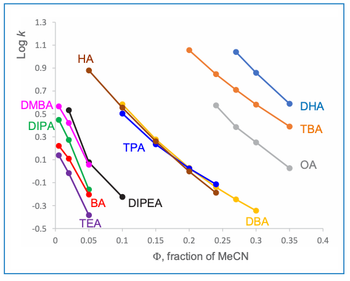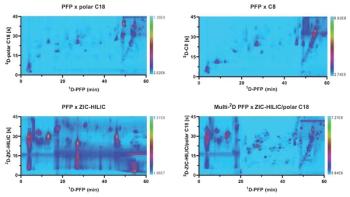
- LCGC North America-02-01-2015
- Volume 33
- Issue 2
Slow Column Equilibration

Why are liquid chromatography retention times sometimes so slow to stabilize?
Why are liquid chromatography retention times sometimes so slow to stabilize?
Through LCGC's international coverage and the liquid chromatography (LC) training classes that I teach around the world, I am exposed to LC-related questions from a variety of laboratories in countries around the world. Although languages, instrumentation, and applications vary widely, it is nice to know that the problems encountered by practicing chromatographers everywhere are very similar. I try to respond to questions promptly (you can contact me via e-mail; see the note at the end of this article) so that you can get on with your work, but I save some of the questions as fodder for my "LC Troubleshooting" installments. This month we'll look at the questions of column flushing and column equilibration that seem to be a fairly regular topic of your inquiries.
Column Cleaning and Reequilibration
Many LC methods are used for the measurement of one or more analytes in a sample matrix of some sort. This matrix may vary from the excipients in a drug product to blood or tissue to plant material to environmental components, such as soil. Often the matrix contains strongly retained compounds that are not of interest. Sample cleanup processes often are used for reducing the burden of these strongly retained materials, but this process is never 100% effective. The result is that most "real" samples contain components that are retained more strongly than the latest-eluted compound of interest. As a result, the column needs to be cleaned occasionally so that these unwanted materials do not build up to the point of causing problems. After the column is cleaned, it may be stored until the next use, or it may be immediately returned to service after reequilibrating with the mobile phase.
The most common column cleaning procedure for isocratic methods is a two-step technique. First, the buffer is removed from the system, then the column is purged with a solvent that is stronger than the mobile phase. Buffer removal is especially important if acetonitrile is used as the strong solvent in a reversed-phase separation because buffers, such as phosphate, often have very poor solubility in high concentrations of acetonitrile. For example, if the mobile phase is 50:50 25 mM phosphate buffer–acetonitrile, the ideal procedure would be to wash with 50:50 water–acetonitrile for 5–10 column volumes to remove the buffer. Alternatively, it may be more convenient to wash with 5–10 column volumes of water, although this can cause the column to go through a process of "dewetting." Dewetting occurs typically for C8 or C18 columns when mobile phase is replaced with water, and the water is unable to penetrate the bonded phase because of the extreme difference in polarity. This is a condition that generally is undesirable and can cause unexpected changes in retention. However, if the dewetting condition is followed by a flush with 100% organic (for example, acetonitrile or methanol), this process will be reversed at the same time the column is washed. After the buffer is removed, flushing with a mobile phase stronger than the normal mobile phase is performed. Most conveniently, this is done by flushing for 10–20 column volumes with the strong solvent, usually acetonitrile or methanol. The column can then be stored in acetonitrile or methanol until it is needed again.
Gradient methods have at least a partial column flush built in, because they run to a strong-solvent condition during each gradient cycle. If late-eluted materials persist, the gradient program can be modified to extend to 100% organic at the end of each run, accomplishing a column flush with each run.
The isocratic or gradient flushing method should be sufficient for most routine reversed-phase methods. Sometimes flushing with a stronger solvent may be useful. In my opinion, flushing with stronger solvents or heroic column restoration procedures usually aren't worth the time. Such techniques may help remove strongly retained materials, but often by the time extreme measures are required, it is rare that the column can be restored to its original performance. I've said here many times that the column should be considered a consumable item, and after 500 or so samples are run, the column doesn't owe you anything - just throw it away if simple flushing doesn't correct the problem.
After the column has been flushed, it usually is best to store the column in the flushing solvent (acetonitrile or methanol) until it is used again. To re-equilibrate to normal operating conditions, equilibration with 10–20 column volumes of mobile phase usually is sufficient.
What Is the Column Volume?
In most cases, it is the volume of solvent passing through the column that is responsible for removing the contaminants or reequilibration, not the flushing time, so an increase in flow rate often can speed the process. The column volume, VM, can be estimated in one of two ways. For 4.6-mm i.d. columns,
where L is the column length in millimeters and the volume is in milliliters. This formula, of course, does not work with columns of other diameters. For such cases, use
where dc is the column diameter in millimeters. Either of these methods give the column volume within approximately 10%. We can see that equation 1 gives a volume of 1.5 mL for a 150 × 4.6 mm i.d. column, whereas equation 2 gives 1.6 mL, both close enough for the present purposes.
An Equilibration Problem
I recently received a reader's question that read like this (in a slightly edited version):
I've developed a method with an ion-pairing reagent of sodium pentanesulfonate. I've come to the conclusion that washing the column with 30 column volumes of 90:10 water–acetonitrile then switching to 40:60 water–acetonitrile is adequate. The problem is that after the wash, some people finish with 10–15 column volumes of 5:95 water–acetonitrile. It seems that this last step is really bad for the column. We know that the ion-pairing reagents are never really completely removed from the column after the wash, so we dedicate the column for ion pairing use only. However, I think that 95% acetonitrile is too strong and may make the ion-pairing reagent precipitate in the column. Normally, after the column is washed with 40:60 water–acetonitrile, then reequilibrated in the mobile phase, we never have problems with the chromatogram for the resolution solution. However, when people introduce the step at 95% acetonitrile, the resolution on the next analysis doesn't pass, and the column does not seem to recover. Even after 3 h of running, the system does not seem to be equilibrated. Does the high concentration of acetonitrile cause the ion-pairing reagent to precipitate on the column, or is there another explanation for these symptoms?
This question highlights several potential problems related to column equilibration. The first is that under ion-pairing conditions, the column is very slow to equilibrate, and for practical purposes after ion-pairing reagents are introduced to the column, they cannot be completely removed. This leads to the common practice of dedicating columns to ion-pairing methods rather than attempting to use them for non-ion-pairing procedures as well. A second problem that occurs with ion pairing is that the equilibration process usually is quite slow. Whereas the rule of thumb is that 10 column volumes of mobile phase is sufficient to equilibrate a column when switching from mixtures of water or buffer and acetonitrile or methanol, it may take 20–50 column volumes, or more, to equilibrate ion-pairing conditions. These, and other problems specific to ion pairing were discussed in an earlier "LC Troubleshooting" installment (1).
Note that the question states that the column is initially washed with a highly aqueous solution (90:10 water–acetonitrile). This follows the suggestion I gave earlier that it is a good idea to flush the buffer (ion-pairing reagent in this case) from the column before flushing with a stronger solvent. In this case, 90:10 water–acetonitrile is ideal because the ion-pairing reagent is water soluble and with 10% acetonitrile present we don't have to be worried about column dewetting. Flushing with nonbuffered mobile phase is very important when acetonitrile is used because buffers and ion-pairing reagents are poorly soluble in high concentrations of acetonitrile. I would be worried that switching directly from mobile phase to 100% acetonitrile would precipitate salts in the column.
My normal recommendation, after the 90:10 water–acetonitrile flush, would be to clean the column with 90–100% acetonitrile, as the reader's colleagues did. However, the reader found that 40:60 water–acetonitrile was sufficient to remove the contaminants he was concerned about, and higher percent acetonitrile flushes had adverse affects on the column. This is one of those cases in which empirical data should override theory - with application of common sense, of course. This is well summarized in my favorite quote from I.M. Kolthoff, "Theory guides, experiment decides." In the present case, 40:60 water–acetonitrile was sufficient for the application and prevented problems that were associated with flushing with stronger solvents. The application of common sense would have us examine the 40:60 water–acetonitrile wash relative to the mobile-phase concentration. I do not know the mobile-phase composition for this method, but I assume that it is no stronger than 40:60 ion pair–acetonitrile. For reversed-phase (which includes ion pairing), the flushing solvent should always be at least as strong as the mobile phase.
The question remains about what happens to make the column behave so poorly after it is flushed with 10:90 water–acetonitrile? I do not think that the problem is related to ion-pairing reagent precipitation, because most of the ion-pairing reagent should have been flushed from the column using the 90:10 water–acetonitrile flush. I do not know if the problem is related to the ion-pairing conditions or the column itself, but it reminds me of an observation we made several years ago about equilibration problems with reversed-phase columns (2).
Slow Column Equilibration
A few years ago during a column testing project in our laboratory, we observed a very odd type of equilibration problem that caused us to look into the issue of column equilibration more deeply (2). This is illustrated in Figure 1. When a new C18 column or one that had been stored in nonbuffered mobile phase was initially equilibrated with a mobile phase of 50:50 pH 2.8 phosphate–acetonitrile, ionized compounds such as amitriptyline showed very slow equilibration. After a 20 column-volume flush of mobile phase, neutral compounds (for example, ethylbenzene), showed constant retention. The retention time for amitriptyline, however, continued to drift for more than 10 h in some cases. This behavior flies in the face of the common rule of thumb that 10–20 column volumes of mobile phase are sufficient to equilibrate a column when changing mobile phase or after flushing the column, except for ion-pairing conditions, as noted above.
Figure 1: Drift of amitriptyline retention after an initial 20-min (20 column volume) equilibration with mobile phase. Column: 150 mm × 4.6 mm C18; mobile phase: 50:50 60 mM potassium phosphate (pH 2.8)–acetonitrile; flow rate: 1.5 mL/min; temperature: 35 °C. Adapted from reference 2.
Further experiments (2) showed that this phenomenon is time-related rather than volume-related. Normally, we observe that column flushing or equilibration is determined by the total volume of solvent passing through the column, not the time. Thus, increasing the flow rate usually reduces the equilibration time. Not so for the slow equilibration problem; it is time, not volume that is important. Slow equilibration seems to be limited to ionized compounds (acids and bases) when buffer is removed or the mobile-phase pH is changed and then initial conditions are restored. Neutral compounds do not seem to be thus affected, and equilibration is complete in the expected <20 column volume interval. Slow equilibration is much less of a problem when higher pH conditions are used (for example, pH 7). As might be expected with a chemical process that is time-related, increased temperature reduces the equilibration time for slow equilibration processes. Finally, based on a limited study of 19 columns from eight manufacturers, it was observed that approximately 40% of the columns exhibited slow equilibration for amitriptyline, whereas the remainder equilibrated quickly.
Practical Considerations
How can we apply the observations discussed above and in reference 2 to a practical benefit in the laboratory? Here are some of my conclusions:
- Because the potential for slow equilibration is widespread when basic compounds at low pH or ion-pairing conditions are used, it is best to use an empirical test for column equilibration when first setting up a method. I would start by flushing 10–20 column volumes of mobile phase through the column, then begin injecting samples, looking for any signs of retention drift. Stable retention times will give an indication of the required equilibration time. If equilibration is rapid, you are home free; if not, you need to take some additional action.
- When slow equilibration is observed, the problem seems to be mitigated by storing the column in mobile phase (2). You may expect somewhat shorter column lifetimes when storing in a buffered mobile phase or ion-pairing conditions than when storing under nonbuffered conditions. However, you need to balance the value of the time spent waiting for the column to equilibrate and the cost of replacing the column more frequently. Column equilibration under slow-equilibration conditions is time-related rather than volume-related, so storage in mobile phase should also save in solvent costs. I do not recommend leaving buffered mobile phase sitting in the LC system because of the danger of buffer precipitation or evaporation and other potential problems. Instead, fill the column with mobile phase, remove it from the system and cap it tightly, then flush the LC system to remove buffered mobile phase. Alternatively, leave the column in the system and reduce the flow rate to a minimum (for example, 0.1 mL/min) to save solvent, yet avoid stagnant mobile phase in the system. If the column is used only occasionally, you might flush the column in the normal manner with unbuffered strong solvent (for example, 100% acetonitrile or methanol), then store it in this solvent. The day before the next use of the column, you could flush it with 10–20 column volumes of mobile phase and store it in this solvent overnight so the column would be fully equilibrated by the next morning.
- The observation of slow equilibration of some columns under non-ion-pairing conditions further underscores the wisdom of dedicating a single column to each LC method. In the long run, your column budget will not be greater and the potential for problems will be lower if each method has its own unique column.
The bottom line here is to pay attention when running an LC method, especially when it is first set up. The common practice of equilibrating for 10–20 column volumes is still a good one, but realize that there are exceptions to the rule.
References
(1) J.W. Dolan, LCGC North Am.26(2), 170–174 (2008).
(2) D.H. Marchand, L.A. Williams, J.W. Dolan, and L.R. Snyder, J. Chromatogr. A1015, 53–64 (2003).
John W. Dolan"LC Troubleshooting" Editor John Dolan has been writing "LC Troubleshooting" for LCGC for more than 30 years. One of the industry's most respected professionals, John is currently the Vice President of and a principal instructor for LC Resources in Lafayette, California. He is also a member of LCGC's editorial advisory board. Direct correspondence about this column via e-mail to
Articles in this issue
almost 11 years ago
The 2015 LCGC Awardsalmost 11 years ago
Retention and Selectivity of Stationary Phases Used in HILICalmost 11 years ago
Pragmatic Rules for GC Column Selectionalmost 11 years ago
Peaks of Interestalmost 11 years ago
Vol 33 No 2 LCGC North America February 2015 Regular Issue PDFNewsletter
Join the global community of analytical scientists who trust LCGC for insights on the latest techniques, trends, and expert solutions in chromatography.




